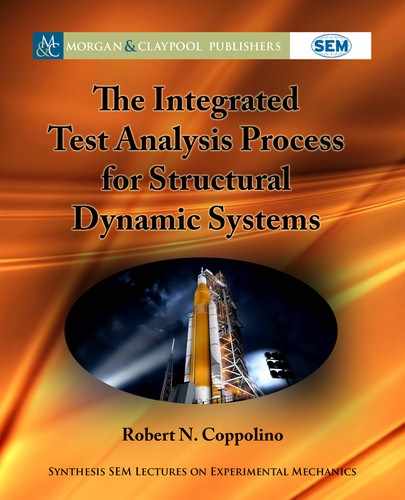92 5. EXPERIMENTAL MODAL ANALYSIS
5.1.6 CLOSURE
Several intuitive experimental modal analysis tools have been described. SDOF frequency re-
sponse functions displayed in three ways, namely: (1) magnitude and phase components vs. fre-
quency; (2) real and imaginary components vs. frequency (also called co- and quad- functions);
and (3) polar real vs. imaginary components vs. frequency. All three display types provide intu-
itive, well-known means for estimation of modal frequency and damping parameters. Review
of FRFs associated with individual FRFs for actual MDOF systems offer some insights for es-
timation of modal frequency and damping parameters when modes are well separated (not the
case for the ISPE test article and other shell-type structures).
Global skyline functions offer some insight into the presence of multiple modes in a des-
ignated frequency band. However, such functions do not necessarily highlight the presence of
localized modes. A more comprehensive approach involving review of many or all measured
FRF response functions is a tedious, time-consuming endeavor.
5.2 PART 2: THE SIMULTANEOUS FREQUENCY DOMAIN
METHOD
5.2.1 INTRODUCTION
Difficulties encountered by NASA/MSFC on the Integrated Spacecraft Payload Element
(ISPE) modal survey in the fall of 2016 bring an important challenge to the forefront. Specifi-
cally, which estimated test modes are “authentic,” and which modes are due to “noise” associated
with measured FRFs? e present discussion on experimental modal analysis (EMA) focuses
on mathematical isolation of individual estimated test mode FRFs in a manner that is similar to
the concept developed by Mayes and Klenke [4]. While the presently discussed EMA approach
ought to be quite independent of the investigator’s choice of experimental modal analysis algo-
rithm, the results herein apply to methods that explicitly estimate the tested system’s state-space
plant matrix such as the Simultaneous Frequency Domain (SFD) method [5–7].
e latest version of SFD (SFD-2018) employs mathematical operations aimed at isolat-
ing individual candidate experimental modes without direct reliance on information associated
with the subject system’s TAM) mass matrix. e key to mathematical and visual isolation of
individual modes from measured data is the left-hand eigenvector. Virtually all modern experi-
mental modal analysis techniques produce estimates of (right-hand) eigenvectors and eigenval-
ues (modal frequency and damping). While techniques for estimation of left-hand eigenvec-
tors are well-known (e.g., the “real mode transpose times TAM mass matrix product” and the
Moore–Penrose pseudo-inverse [8]), they have been judged inadequate. e purest approach to
estimation of left-hand eigenvectors is a consequence specifically those techniques that estimate
the measured system’s plant or effective dynamic system matrix, such as SFD. Since a complete
set of raw experimental modes are identified consistent with the order of the estimated plant, the
..................Content has been hidden....................
You can't read the all page of ebook, please click here login for view all page.
